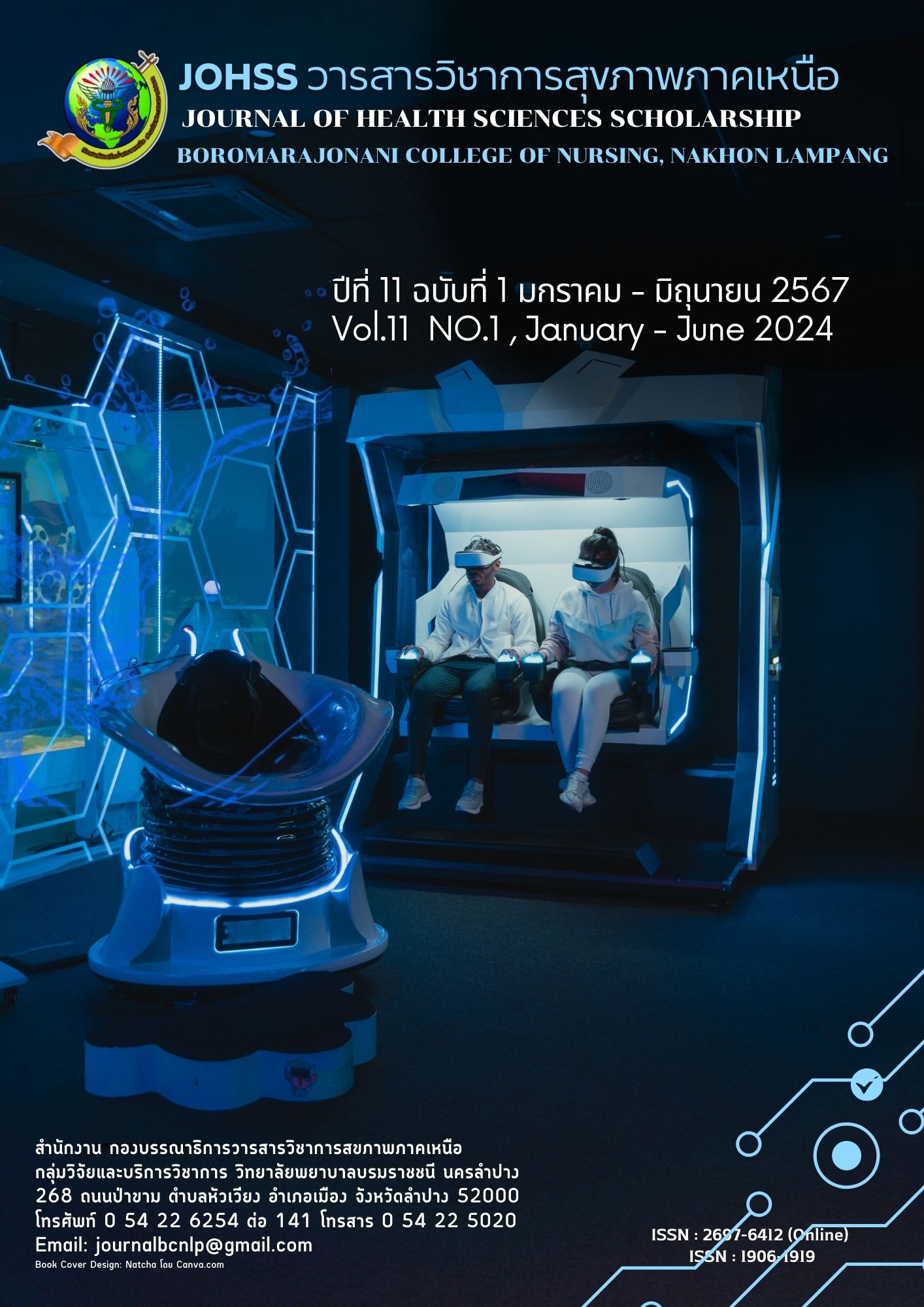ความเครียด ภาวะซึมเศร้าและปัจจัยที่สัมพันธ์กับความเครียดและภาวะซึมเศร้าในผู้ป่วย โรคโควิด-19 ที่มารับการรักษาในหอผู้ป่วยติดเชื้อ โรงพยาบาลห้วยคต อำเภอห้วยคต จังหวัดอุทัยธานี
บทคัดย่อ
การวิจัยนี้เป็นการวิจัยพรรณนาแบบภาคตัดขวางเพื่อศึกษาความเครียด ภาวะซึมเศร้า และปัจจัยที่สัมพันธ์กับความเครียดและภาวะซึมเศร้าในผู้ป่วยโรคโควิด-19 ที่มารับการรักษาใน หอผู้ป่วยติดเชื้อโรงพยาบาลห้วยคต อำเภอห้วยคต จังหวัดอุทัยธานี เลือกกลุ่มตัวอย่างแบบเฉพาะเจาะจงในผู้ป่วยโรคโควิด-19 ที่ได้รับการตรวจยืนยันด้วยวิธีการตรวจ RT-PCR จำนวน 107 คน เครื่องมือที่ใช้ในการเก็บข้อมูล คือ แบบประเมินปัจจัยที่เกี่ยวข้อง ตรวจสอบความตรงเชิงเนื้อหาโดยผู้ทรงคุณวุฒิ และแบบประเมินความเครียดและแบบคัดกรองโรคซึมเศร้าและวิเคราะห์ค่าความเที่ยงมีค่าเท่ากับ .86 และ .96 ตามลำดับ ประกอบด้วย 4 ตอน คือ ตอนที่ 1) ปัจจัยส่วนบุคคล ตอนที่ 2) ปัจจัยที่เกี่ยวข้อง ตอนที่ 3) แบบประเมินความเครียด และตอนที่ 4) แบบประเมินโรคซึมเศร้า วิเคราะห์ข้อมูลสถิติเชิงพรรณนาโดยใช้สถิติความถี่ ร้อยละ และวิเคราะห์ปัจจัยที่สัมพันธ์ด้วยสถิติ Chi-square
ผลการศึกษาพบว่า ความเครียดในผู้ป่วยโรคโควิด-19 แบ่งเป็น ความเครียดระดับน้อยร้อยละ 90.7 ระดับปานกลางร้อยละ 9.3 และพบว่าปัจจัยที่สัมพันธ์กับระดับความเครียด ได้แก่ ปัญหาสังคม (c² =17.250) อย่างมีนัยสำคัญทางสถิติ (p<.001) และ ปัญหาครอบครัว (c² =4.79) อย่างมีนัยสำคัญทางสถิติ(p<.05) ภาวะซึมเศร้าในผู้ป่วยโรคโควิด-19 พบร้อยละ 41.4 โดยแบ่งเป็นระดับน้อยร้อยละ 38.3 ระดับปานกลางร้อยละ 2.8 และพบว่าปัจจัยที่สัมพันธ์กับภาวะซึมเศร้า ได้แก่ ปัญหาสังคม (c² =28.205) และปัญหาครอบครัว (c² =18.531) ตามลำดับ อย่างมีนัยสำคัญทางสถิติ (p<.001) ส่วนโรคประจำตัว (c² =17.369) มีความสัมพันธ์กับภาวะซึมเศร้าในผู้ป่วยโรคโควิด-19 อย่างมีนัยสำคัญทางสถิติ (p<.05)
เอกสารอ้างอิง
Aguilera, D. C. (1989). Crisis intervention. In L. M. Birckhead (Ed.) Psychiatric/mental health
Nursing (pp. 229-250) Philadelphia.
Aurel, P. (2020). Depressive Symptoms, Anxiety Disorder, and Suicide Risk During the COVID-19
Pandemic. (Online), Available : https://www.frontiersin.org/articles/10.3389/fpsyg.2020.
/full (2021, December 22).
Brooks, S. K., et al. (2020). The psychological impact of quarantine and how to reduce it: Rapid review of the evidence. The Lancet Psychiatry, 395(10227), 912-920.
Boondiskulchok, S., Weerametachai, S., & Leesr, T. (2022). Prevalence and associated factors of
Stress and Depression among SARS-Cov-2 patient in field hospital, Saraburi hospital.
Regional Health Promotion Center 9 Journal, 16(2), 367-379. (In Thai).
Chanaudomsuk, S., & Thammakun, T. (2022). Stress Conditions During COVID-19 Crisis of Health Personnel in Pran Buri District, Prachuab Khiri Khan Province. The Office of Disease Prevention and Control 10th Journal, 20(1), 63-76. (In Thai).
Cuiya, W. (2020). Immediate Psychological Responses and Associated Factors during the Initial Stage of the 2019Coronavirus Disease (COVID-19) Epidemic among the General Population in China. (Online), Available:https://www.ncbi.nlm.nih.gov/.pmc/articles/PMC7084952/. (2021, December 22).
Chumpupan, N. (2019). Anxiety and Depression in Persons with Osteoarthritis of Knee. Chulalongkorn University Theses and Dissertations (Chula ETD). [cited 2022 May 17]. available from: https://digital.car.chula.ac.th/chulaetd/9784 (in Thai).
Department of Mental Health. (2017). Depression Assessment. Nonthaburi: Ministry of Mental Health. (in Thai).
Folkman, S. (2013). Stress: Appraisal and Coping. In M. D. Gellman & J. R. Turner (Eds.). Encyclopedia of Behavioral Medicine (pp. 1913-1915). Springer.
Galea, S., et al. (2020). Population health science in the time of coronavirus disease 2019. American Journal of Epidemiology, 189(9), 859-860.
Holmes, E. A., et al. (2020). Multidisciplinary research priorities for the COVID-19 pandemic: A call for action for mental health science. The Lancet Psychiatry, 7(6), 547-560.
Jirawikrankul, S. (2020). Factors related to stress and depression in patients who receive gastrointestinal endoscopy servicesat Chamni Hospital, Buriram Province. Journal of Suicide Prevention of Thailand, 1(1), 57-68. (In Thai).
Kijwattanaphokin, K., & Wijitraphan, T. (2022). Prevalence and factors related to anxiety.Stress and depression in the situation of the spread of COVID-19 among employees of a factory in San Pa Tong District, Chiang Mai Province. Journal of Health Science, 31(3), 393-403. (in Thai).
Ministry of Public Health. Department of Mental Health. (2015). Guidelines for using mental health tools for personnel Public Health in Community Hospitals. Nonthaburi: Ministry of Public Health. (in Thai).
Nualsithong, N., et al. (2021). Stress and Depression of the Elderly with Chronic Diseases in Na Siew Sub-district, Muang Chaiyaphum District, Chaiyaphum Province. The Public Health Journal of Burapha University, 16(2), 78–89.
Petchan, S., & Nawsuwan, K. (2022). Comparison of Stress, Anxiety, and Sadness among COVID-19 Patients during Sickness and After Sickness,Wang Yai Subdistrict Health Promoting Hospital, Na Thawi Distict, Songkhia Province. Journal of Nursing and Public Health Research, 2(3), 48-56. (in Thai).
Sangchan, S., & Sukasam, K. (2022). Factors affecting stress of population in bangkok area during the covid-19 virus outbreak situation.Valaya Alongkorn Review, 12(2), 218-230. (in Thai)
Sawangsri, W., et al. (2021). Prevalence of perceived stress and depression and their associated factors among COVID-19 patients in Bangkok. (Online), Available:https://he01.tci-thaijo.org/index.php/jmht/article/view/245881/169146. (2021, December 22). (in Thai)
Salari, N., et al. (2020). Prevalence of stress, anxiety, depression among the general population during the COVID-19 pandemic: A systematic review and meta-analysis. Globalization and Health, 16(1), 57.
Silpakit, O. (2008). Srithanya stress scale. Journal of Mental Health of Thailand, 16(3), 177-185. (in Thai).
Sompunga, W., & Phuipha, T. (2023). Stress and Depression in COVID-19 Pandemic among the People Sisaket Province. Journal of The Royal Thai Army Nurses, 24(1), 172-181. (In Thai).
Stree, H., Sheeran, P., & Orbell, S. (1999). Conceptualizing Depression: An Integration of 27 Theories. Clinical Psychology and Psychotherapy, 6(3), 175-193.
Taquet, M., et al. (2021). Bidirectional associations between COVID-19 and psychiatric disorder: Retrospective cohort studies of 62 354 COVID-19 cases in the USA. The Lancet Psychiatry, 8(2), 130-140.
Wang, Q. Q., et al. (2020). The role of smoking in COVID-19 severity: A review of recent evidence. International Journal of Environmental Research and Public Health, 17(20), 7454.
Wanthana, N., & Arrom, A. (2022). Stress Management and Related Factors of Work Life Quality Management. (Online), Available from : https://www.aru.ac.th/myadmin/uploads/rdi/download/20201129-e43890dd.pdf. (2021, December 22). (in Thai).
Wongpiromsarn, Y. (2020). Mental health and the COVID-19 crisis in Thailand. J Ment Health Thail, 28(4), 280-291. (in Thai).
World Health Organization. (2020). Mental health and psychosocial considerations during the COVID-19 outbreak [Internet]. Geneva: World Health Organization (WHO); c2020 [cited 2022 May 17]. Available from:
https://www.who.int/docs/ default-source/coronaviruse/mental-health-considerations.pdf (in Thai)
Xiong, J., et al. (2020). Impact of COVID-19 pandemic on mental health in the general population: A systematic review. Journal of Affective Disorders, 277, 55-64
ดาวน์โหลด
เผยแพร่แล้ว
ฉบับ
ประเภทบทความ
สัญญาอนุญาต
ลิขสิทธิ์ (c) 2024 วิทยาลัยพยาบาลบรมราชชนนี นครลำปาง

อนุญาตภายใต้เงื่อนไข Creative Commons Attribution-NonCommercial-NoDerivatives 4.0 International License.
บทความ ข้อมูล เนื้อหา รูปภาพ ฯลฯ ที่ได้รับการตีพิมพ์ในวารสารวารสารวิชาการสุขภาพภาคเหนือ ถือเป็นลิขสิทธิ์ของวารสารวารสารวิชาการสุขภาพภาคเหนือ หากบุคคลหรือหน่วยงานใดต้องการนำทั้งหมดหรือส่วนหนึ่งส่วนใดไปเผยแพร่ต่อหรือเพื่อกระทำการใดๆ จะต้องได้รับอนุญาตเป็นลายลักอักษรจากวารสารวารสารวิชาการสุขภาพภาคเหนือก่อนเท่านั้น
เนื้อหาและข้อมูลในบทความที่ลงตีพิมพ์ในวารสารวิชาการสุขภาพภาคเหนือถือเป็นข้อคิดเห็นและความรับผิดชอบของผู้เขียนบทความโดยตรงซึ่งกองบรรณาธิการวารสาร ไม่จำเป็นต้องเห็นด้วย หรือร่วมรับผิดชอบใดๆ
อนึ่ง ข้อความและข้อคิดเห็นต่างๆ เป็นของผู้เขียนบทความนั้นๆ ไม่ถือเป็นความเห็นของวารสารฯ และวารสารฯ ไม่จำเป็นต้องเห็นด้วยกับข้อความและข้อคิดเห็นใดๆ ของผู้เขียน วารสารฯ ขอสงวนสิทธิ์ในการพิจารณาตีพิมพ์ตามความเหมาะสม รวมทั้งการตรวจทานแก้ไขหรือขัดเกลาภาษาให้ถูกต้องตามเกณฑ์ที่กำหนด



